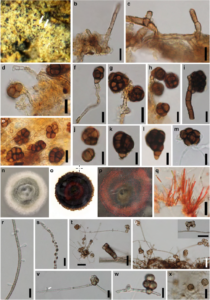Pseudomonodictys tectonae Doilom, Ariyawansa, D.J. Bhat & K.D. Hyde.
Index Fungorum number: IF551349; Facesoffungi number: FoF00907; Fig. 1
Etymology – Name refers to the host genus Tectona on which the fungus was collected.
Holotype – MFLU 15-1413
Saprobic on dead wood of Tectona grandis L.f. Sexual morph: Undetermined. Asexual morph: Colonies on natural substrate, superficial, scattered, solitary to gregarious, black. Conidiophores up to 60 μm long, 2.5 – 5 μm wide, semi-macronematous to sometimes macronematous, erect to slightly curved, septate, branched, slightly constricted at the septa, pale brown to brown. Conidiogenous cells holoblastic, doliform, integrated, terminal or intercalary, indeterminate, smooth to verrucose, pale brown. Conidia (13–) 16 – 17 (−22) × (14–) 16 – 19 (−25) diam. μm (x̄ = 16 × 17 μm, n = 20), dictyosporous, muriform, top-shaped, initially subglobose with 1 – 2 cells, becoming ellipsoidal to irregular with several cells, acropleurogenous, reddishbrown to dark brown, solitary, with granules, with a protruding basal cell; truncate to slightly rounded at the base.
Culture characteristics – Conidia germinating on PDA within 24 h. Germ tubes produced from the basal cells. Colonies on PDA reaching 21 – 23 mm diam. after 7 days in the dark at 25 °C (x̄ = 22.5 mm n = 5), with entire edge, raised, circular, superficial at the centre, velvety, medium dense, olive grey (3 F2) at the centre, white (3A1) at the edge after 7 days. Mycelium comprising 2 – 3 μm wide, partly superficial, verrucose, pale brown to dark brown, septate, branched hyphae. Conidiophores semi-macronematous to macronematous, erect to slightly curved, mostly creeping, initially subhyaline, later becoming brown to pale brown. Conidiogenous cells holoblastic, doliform, integrated, terminal, terminal or intercalary, indeterminate. Conidia (8–) 15 – 19 (−22) × (9–) 14 – 16 (−19) diam. μm (x̄ = 16 × 14 μm, n = 30), produced on aerial mycelium, dictyosporous, pale brown to reddish-brown, initially subglobose with 1 – 2 cells, becoming ellipsoidal or cylindrical to irregular with several cells, solitary or rarely catenate, with granular contents, with a protruding basal cell; truncate to slightly rounded at the base. Chlamydospores develop in culture, catenate, intercalary or terminal, initially hyaline and becoming brown to dark brown with maturity, subglobose to ellipsoidal, thick-walled, smooth. Mycelium with rod shaped, septate, erect hyphae, up to 60 μm long, 0.6 – 1.7 μm diam., producing red pigments in PDA medium.
Material examined − THAILAND, Chiang Rai Province, Mae Suai District, Mae Lao garden, on dead wood of Tectona grandis, 18 August 2012, M. Doilom MKT 68 (MFLU 15-1413, holotype), ex-type living culture, (MFLUCC 12-0552).

Fig. 1 Pseudomonodictys tectonae (holotype) a Conidia on dead wood of Tectona grandis (arrows) b, c Mycelia bearing conidiophores d – i Conidia attached to conidiophores e – l Conidia m Germinating conidia n Seven day-old colony (from above) on PDA o Eight month – old colony (reverse view) on PDA p Close-up red pigment on PDA q Crystals of red pigment r Conidiophores producing immature conidia s Conidiophores t – w Conidiophores with conidia and immature conidia (arrow) x Chlamydospores. Scale bars: b – m, r, s, v – x = 10 μm, q, t, u = 20 μm.
